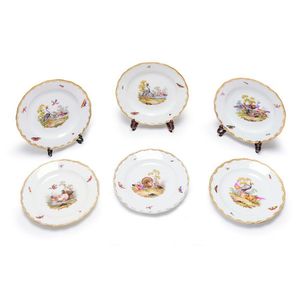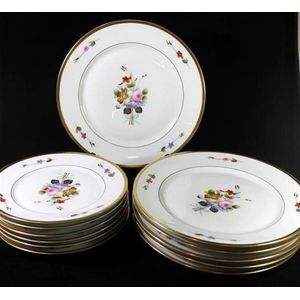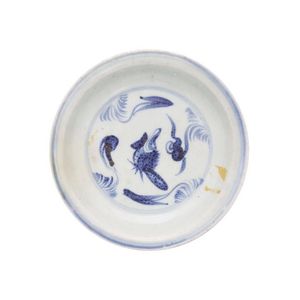Wedgwood Creamware Armorial Dishes Collection
You must be a subscriber, and be logged in to view price and dealer details.
Subscribe Now to view actual auction price for this item
When you subscribe, you have the option of setting the currency in which to display prices to $Au, $US, $NZ or Stg.
- Armorial / Armourial - Bearing a coat of arms. Coats of arms came into general use by feudal lords and knights in in the 12th century, and by the 13th century, arms had spread beyond their initial battlefield use to become a flag or emblem for families in the higher social classes of Europe. They were inherited from one generation to the next. When a family crest is used on individual items of silver or furniture it is an indicator of the aristocratic standing of the family represented.
Armorials were also used to decorate mass produced ceramic souvenir ware by such companies as Goss, Carlton & Shelley, and in these cases the coats of arms displayed were of boroughs and cities. - Creamware - Creamware, also known as "Queens Ware" is the
cream-coloured English earthenware developed by Josiah Wedgwood in the 1760s.
The invention of creamware was the result of experimentation in order to find a
British substitute for imported Chinese porcelain, and the cream colour was
considered a fault at the time. The lightweight fine white earthenware with a
clean rich yellowish proved ideal for tableware
and decorative items during the 18th and 19th centuries and is still produced
today.
Creamware is made from a
mixture of kaolin, feldspar, and ball clay, and is typically glazed before
firing to give it its glossy finish. It was developed by British potters as a
cheaper alternative to porcelain.
At Wedgwood, Royal patronage
boosted sales. In 1765 Queen Charlotte, the consort of King George III placed
an order for a 12 place tea set and allowed Wedgwood to use the name
"Queens Ware" for the line. In 1770 Wedgwood produced a creamware
dinner service of 952 pieces supplied to Catherine II the Great of Russia.
Other potteries such as
Doulton, Neale & Co. and Spode produced smaller quantities of creamware.
Creamware continued to be
made throughout the 19th century and later. - Circa - A Latin term meaning 'about', often used in the antique trade to give an approximate date for the piece, usually considered to be five years on either side of the circa year. Thus, circa 1900 means the piece was made about 1900, probably between 1895 and 1905. The expression is sometimes abbreviated to c.1900.
This item has been included into following indexes:
- Wedgwood (England), item types
Visually similar items

A set of six Meissen porcelain plates, circa 1880, each plate hand painted with exotic birds to centre, and butterfly designs to rim, blue under glazed double sword mark to underside, 23.5 cm diameter

A set of twelve hand-decorated Haviland Limoges 'Plates, Seach each dinner and entree

Early Chinese porcelain dish, decorated in underglaze blue with a fish among weed. Signs of use and small firing faults to rim. Diameter 18 cm

Pair of 20th century Chinese celadon bowls, each with incised decoration. 30 cm wide.
